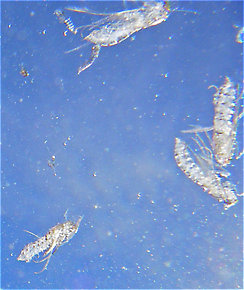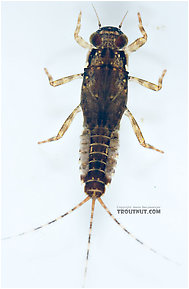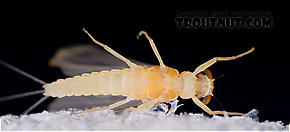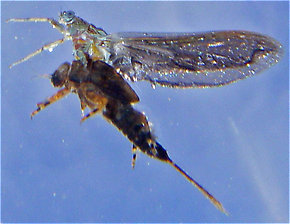Blog & Latest Updates
Fly Fishing Articles
Insects by Common Name


Mayfly Species Ephemerella dorothea dorothea (Pale Evening Dun)
Taxonomic Navigation -?-
Kingdom
Animalia (Animals)
» Phylum
Arthropoda (Arthropods)
» Class
Insecta (Insects)
» Order
Ephemeroptera (Mayflies)
» Species dorothea dorothea (Pale Evening Dun)
Common Names
This is one of the most challenging mayfly hatches on Eastern waters. On many streams, it follows or overlaps hatches of the larger, lingering Ephemerella invaria.
Where & When
Regions: East, Midwest
Time Of Year (?): May-July, often best in June.
Preferred Waters: Perhaps most common in mountain streams, but especially good in some alkaline (Alkaline: Having a pH higher than 7 (opposite of acidic). Moderately alkaline water is ideal for trout because it's better for the growth of phytoplankton, the usual base of the aquatic food chain, and that's good for the growth of everything higher up the chain, including trout.) spring creeks.
This Eastern subspecies (Subspecies: Entomologists sometimes further divide a species into distinct groups called subspecies, which have two lower-case words on the end of their scientific name instead of one. The latter is the sub-species name. For example, Maccaffertium mexicanum mexicanum and Maccaffertium mexicanum integrum are two different subspecies of Maccaffertium mexicanum.) begins to emerge in late May in Pennsylvania. It progresses through the Catskills in early June and peaks in mid-June farther north, lasting as late as early July in some places.Time Of Year (?): May-July, often best in June.
Preferred Waters: Perhaps most common in mountain streams, but especially good in some alkaline (Alkaline: Having a pH higher than 7 (opposite of acidic). Moderately alkaline water is ideal for trout because it's better for the growth of phytoplankton, the usual base of the aquatic food chain, and that's good for the growth of everything higher up the chain, including trout.) spring creeks.
Hatching Behavior
Time Of Day (?): Flexible, but typically mid-late evening
Habitat: Slow water
Water Temperature: 60-65°F
These insects are actually too perfect for dry fly fishing, which makes matching their hatches difficult.Habitat: Slow water
Water Temperature: 60-65°F
The nymphs may drift for a while just below the surface before trying to break through. When they do, it takes them a long time to crawl out of their shucks (

Here's an underwater view of the pupal shucks of several already-emerged Brachycentrus numerosus caddisflies.
These Sulphurs emerge from smooth, slow water, which allows the trout maximum time to inspect their prey. Because a rising trout may be selective to either floating nymphs, emergers, duns, cripples (Cripple: In fly fishing, a cripple is any insect which has been injured or deformed so that it cannot escape the water. This may include stillborn emergers or fully emerged adults which have been damaged, often by wind or waves, so that they can no longer fly. Trout often favor eating crippled insects.), or spinners, this is one of the most puzzling hatches in all fly fishing. It is also difficult because the flies are small, hook size 16 to 18, and such small imitations are prone to microdrag (Microdrag: The imperceptibly small unnatural motions of an artificial fly on the water, caused by its connection to the line. A trout's whole life is spent watching things drift naturally, and unnatural movement too subtle for us to detect is obvious to their specialized senses.). There is no better time to hone your powers of observation and presentation.
Spinner Behavior
Time Of Day: Near dusk
Habitat: Riffles are preferred, but on spring creeks without riffles any broken water will do.
Hatched duns typically return to the stream within two days as spinners. After mating, both genders fall spent (Spent: The wing position of many aquatic insects when they fall on the water after mating. The wings of both sides lay flat on the water. The word may be used to describe insects with their wings in that position, as well as the position itself.) on the water.Habitat: Riffles are preferred, but on spring creeks without riffles any broken water will do.
Females usually, but not always, drop their eggs from the air above the stream. When they do end up on the water with egg sacs still attached, trout may become selective to spinners with little yellow dots near the tail. Patterns are sold to imitate this.
Nymph Biology
Current Speed: Some in riffles and runs, but best in slower stream sections and pools.
Substrate: Gravel, sand, vegetation
The nymphs display the usual Ephemerellidae habits of high activity in the hours and days before they hatch, and trout claim many of them before they're anywhere near the surface.Substrate: Gravel, sand, vegetation
Ephemerella dorothea dorothea Fly Fishing Tips
See the section on Hatching Behavior above regarding the many challenges this hatch poses. The best approach is extremely keen observation, and the standby is rapid-fire trial and error. Do not stick with one thing for very long if it's not working.
Caucci and Nastasi note in Hatches II that some light-bodied species of Epeorus, such as Epeorus vitreus, may emerge at the same time as dorothea in the East. It's just one more entry in the long list of complications of the dorothea Sulphurs.
Pictures of 2 Mayfly Specimens in the Species Ephemerella dorothea dorothea:
Ephemerella dorothea dorothea (Pale Evening Dun) Mayfly Nymph View 6 PicturesI keyed this nymph carefully under a microscope to check that it's Ephemerella dorothea.
View 6 PicturesI keyed this nymph carefully under a microscope to check that it's Ephemerella dorothea.
 View 6 PicturesI keyed this nymph carefully under a microscope to check that it's Ephemerella dorothea.
View 6 PicturesI keyed this nymph carefully under a microscope to check that it's Ephemerella dorothea.Collected May 29, 2007 from Paradise Creek in Pennsylvania
Added to Troutnut.com by Troutnut on June 4, 2007
Added to Troutnut.com by Troutnut on June 4, 2007
Male Ephemerella dorothea dorothea (Pale Evening Dun) Mayfly Dun View 5 Pictures
View 5 Pictures
 View 5 Pictures
View 5 PicturesCollected May 27, 2007 from Brodhead Creek in Pennsylvania
Added to Troutnut.com by Troutnut on June 4, 2007
Added to Troutnut.com by Troutnut on June 4, 2007
Recent Discussions of Ephemerella dorothea dorothea
Wow, they really can take forever to get off the water 36 Replies »
I watched quite a few of these guys emerge tonight. (I think -- they seemed too small and light to be Ephemerella invaria, though I didn't bring one home to check under the microscope.) It was a cool evening but not cold, and they were emerging on the slow flats of a large midwestern spring creek. I watched several of them drift 50+ feet on the very slow-moving water, slowly rising up out of the surface film. Their emergence was sporadic and lucky for them the trout were also sporadic. Many were eaten but others went ignored for their entire lengthy drifts.
Later in the evening I was bested by a half-dozen rising trout. The sulphurs were still emerging, and a mix of spinners was starting to appear on the water, but I didn't get so much as a splashy refusal from several rising fish, even in the low light of dusk. My best guess is that they were picky feeders keying on a stage of Ephemerella dorothea mayflies.
ReplyLater in the evening I was bested by a half-dozen rising trout. The sulphurs were still emerging, and a mix of spinners was starting to appear on the water, but I didn't get so much as a splashy refusal from several rising fish, even in the low light of dusk. My best guess is that they were picky feeders keying on a stage of Ephemerella dorothea mayflies.
Your Thoughts On Ephemerella dorothea dorothea:
Top 10 Fly Hatches
Top Gift Shop Designs
Eat mayflies.
Top Insect Specimens
Miscellaneous Sites
Troutnut.com is copyright © 2004-2024 Jason
Neuswanger (email Jason). See my FAQ for information about use of my images.
 privacy policy
privacy policy

